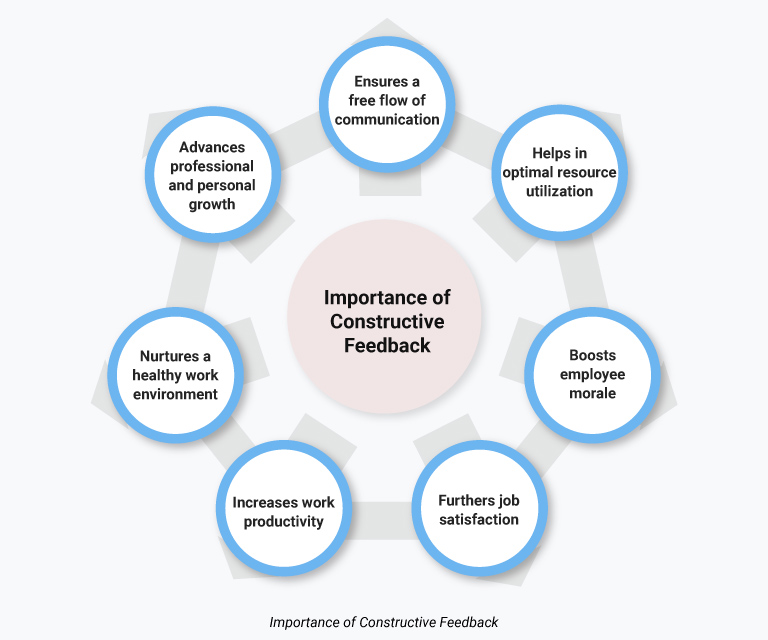March 23, 2023
Value of a Constructive Feedback in the Workplace

It is easy to say than do. Yes, I am talking about giving constructive feedback to your direct reports. It may be nerve-wracking for managers to provide positive and productive feedback, but it is crucial for thriving in the workplace. It aids your people in growing more flexible, developing new skills and capabilities, and getting into multiple roles. Without effective feedback, it becomes difficult for your employees to accomplish their goals and, ultimately, drive business value. But, to give feedback respectfully and productively, let us start with the basics.
What is Constructive Feedback?
It is a kind of supportive feedback that managers give their team members, thus helping them recognize solutions to their areas of weakness. Constructive feedback is positively intended and utilized as a supportive communication tool to address specific concerns or issues. This feedback can be given in varied forms, like praise and criticism. The outcomes of constructive feedback are quicker work processes, corrected weaknesses, improved behaviors, and offering new perspectives. Remember, good constructive feedback must focus on the work and should not be a personal negative attack against an individual.
Constructive Feedback Examples
Irrespective of where your organization falls on the feedback spectrum, having solid constructive feedback examples helps to set up your people for success.
Constructive Feedback Example on Communication
Scenario: An employee faces issues building rapport due to poor communication skills in client meetings.
Example: “I have observed you dive right into the presentation during customer and prospect meetings. Ensure you get to know everyone as people, and only then can you build a relationship and bond. In your next meeting, why not learn more about your prospects’ work, priorities, and life outside the office?”
Constructive Feedback Example on Collaboration
Scenario: An employee likes to dominate a cross-functional project. He refrains from often accepting new ways of doing things.
Example: “I have found that two team members voiced ideas, but you shut them down. It feels like new solutions to problems or ideas are not welcome. Is there no way to explore some of these ideas? I believe it would help to show we are team players and look forward to encouraging people’s contributions to the ongoing project”.
Constructive Feedback Example on Time Management
Scenario: A direct report for whom it is challenging to meet deadlines.
Example: “Thank you for informing me that you are running behind schedule and need an extension. This is the fourth time you have requested an extension in the past month. It will be a good proposition to enlist projects and how much time you spend on each project. Let us see how you manage your time and recognize inefficiencies.”
Constructive Feedback Example on Boundaries
Scenario: An employee is responsible for delegating work to other team members.
Example: “I have observed you have delegated a few parts of the ongoing project and those that fall into your scope of work. Though my plate is full of responsibilities in making this website live right now if you need help, it might be worth bringing up your workload to me, your manager.”
Constructive Feedback Example on Managing
Scenario: A team manager is struggling to engage his remote team.
Example: “I have had a few meetings with your team, and they felt a lack of connections. In this remote working model, some of your team members experience isolation. Act together with your team and put in place virtual team-building activities.”
Top 5 Ways to Offer Constructive Feedback
Build and Maintain Trust
Managers must establish an open and trustworthy relationship with their direct reports. When there is a baseline of trust, you can easily set the tone for future conversations with them. You can also deliver feedback, with your direct reports accepting the feedback and working on your suggestions. As a leader, your direct report must feel that you identify their abilities, trust their potential, and appreciate their work. They will thus be open to your feedback and view it as constructive.
Be Specific
Offer the other person suggestions based on your observation and their response. As you focus on specifics, you can give constructive feedback. For instance, telling someone their presentation structure is strong but lacks important information on a specific topic is an appropriate way to help them feel good about what they have done. You may thus instruct them specifically on what they must do to bring it up to par. The same goes for positive feedback too. Don’t just say “nice or great job”. You must give a meaningful compliment showing you took the time to look at their work and truly appreciated it.
Don’t Go Personal
You need to note while giving feedback, to differentiate the person from their actions. It is not a good practice to judge the person; instead, focus on the issue. You may pinpoint to the person that you observed some errors in a recent report, so they should take time to proofread their work in the future. But don’t tell him directly that they are a careless writer. If the other person feels that you are attacking him personally, the individual is more likely to shut down and loses trust in you without listening to what you have to say.
Make the Best Use of Emotional Intelligence
Before you share feedback, check your emotional state. You shouldn’t be angry or anxious. If your emotional state is not right when giving positive or negative feedback, you may be broaching an attack that could backfire. You must manage your emotions to get the desired result. First, consider how the feedback you must deliver affects you personally. Second, understand how that feedback affects the receiver and the team’s productivity.
Offer Consistent Feedback
The frequency of feedback or constructive criticism depends on how much interaction you have with the individual or team member. Still, you should make feedback a regular part of your meetings and conversations. An employee engagement platform, like UnlockTalent, enables you to request, receive, and give feedback. When the feedback exercise happens frequently, the manager and his direct report are on the same page regarding expectations and performance. Moreover, the manager will be better prepared to give the requisite feedback, and team members will be much more ready to receive it.
Importance of Constructive Feedback

